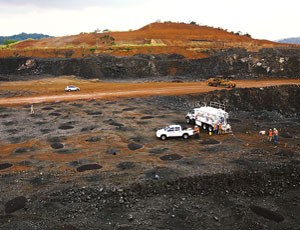This dry excavation, requiring removal of 47 million cu m, is needed to create the Pacific locks access channel–a 6.7-kilometer link between the existing navigation channel and the new locks to be built next to the Miraflores Locks. The Cocoli River, which empties into Miraflores Lake, is being rerouted 3.5 km. The 5 km-long Borinquen Road was also relocated.



Another tricky aspect has been the removal of unexploded ordinance from a former U.S. Army firing range. Almost 330 hectares had to be painstakingly cleared.
Three contracts worth a total of $103 million have been awarded by the Panama Canal Authority (ACP). The fourth and largest contract, PAC 4, is to be awarded this summer, says Jorge Quijano, the ACP executive vice president in charge of the expansion effort. PAC 4 will include removal of 26 million cu m below the existing water level.
The Pedro Miguel and Miraflores locks are located at either end of the 2.5-km-long Miraflores Lake. The new channel will run roughly parallel but 0.5 m higher than the lake level.
A key component of PAC 4 will be a clay-core dam. When completed, the Borinquen Dam will be more than 2 km long and 30 m high. The rock will come from nearby excavations.
The first contract, PAC 1, awarded in 2007 to Panama’s Constructora Urbana SA (CUSA) for $41.1 million, required removing 7.4 million cu m of material from a hill and relocating most of the road. It is almost completed.
In December 2007, Consorcio Cilsa Minera, a joint venture of Mexico’s Constructora de Infraestructura Latinoamericana SA (CILSA) and Panama’s Minera María won the second contract for $25.5 million. More than half of the 7.5 million cu m of material has been removed from this 2.4-km stretch, which includes the diversion of the Cocoli River.
PAC 3 was awarded to the Costa Rican firm Constructora Meco for $36.7 million last December. The bulk of the 8 million cu m to be removed lies beneath PAC 1, requiring the majority of work on that contract to be completed first.



Post a comment to this article
Report Abusive Comment